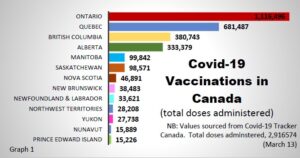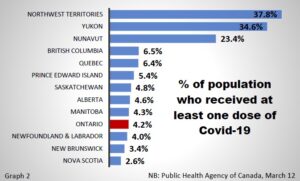Trouble with the rate of Covid-19 vaccinations
[GTranslate]TORONTO – Spring is just days away. The weather is improving, Covid-19 restrictions are slowly easing and more people are moving about. But the focus remains the race between vaccinations and variants of concern.
Since the start of the Covid-19 vaccination campaign, Canada has received more than 3.9 million doses of vaccines, according to the Covid-19 Vaccination Tracker Canada. Of the supply available, Canada has administered more than 2.9 million doses.
Roughly 5.1% of the country’s population have received at least one shot. Several studies suggest close to 80% of the population would need to be vaccinated against Covid-19 to achieve herd immunity. Canada has a way to go.
The vaccines approved for use in Canada – Pfizer, Moderna and AstraZeneca – all require two doses several weeks apart to achieve proper protection. The fourth vaccine – Johnson & Johnson – approved by health regulators is the only one requiring a single dose.
Initial estimates were that any Canadian wishing to get a Covid-19 vaccine could do so by September 2021. Now, as more shipments arrive and additional vaccination sites become accessible to the public, some officials suggest there is flexibility in that timeline.
For instance, in Ontario, an additional two million doses are scheduled to arrive before the end of March. Once the province enters Phase Two of the vaccine rollout, between April-July, it is expected that up to nine million Ontarians will be vaccinated. This phase will open up priority to people with high-risk chronic conditions, individuals who live and work in high-risk congregate settings and communities at greater risk.
Thus far, Ontario has only vaccinated priority groups in phase one of the rollout. Those given first access include: staff, essential caregivers and residents of long-term care homes, high-risk retirement homes and First Nations elder care homes. This phase also includes healthcare workers identified as high priority, Indigenous adults, people aged 80+ and adult recipients of chronic home care.
Since the start of the vaccination campaign, Ontario has administered the most vaccinations (over one million doses) compared to other provinces and territories. (see chart above)
However, when considering the percent of the population that has received at lease one shot, Ontario’s rate of 4.2% falls behind that of other provinces such as Quebec, at 6.4% and British Colombia, at 6.5%. (see graph 2)
Last week, Ontario expanded its vaccine rollout. On March 12, over 325 pharmacies across Ontario began offering the AstraZeneca vaccine to eligible Ontarians aged 60-64 (by appointment) as part of the vaccine delivery pilot program. The participating pharmacies are located in the public health units of Toronto, Kingston, Windsor-Essex, Frontenac, Lennox and Addington. As supply increases, additional regions will be added to the rollout.
The campaign received another boost after physicians began administering Covid-19 vaccines. The initiative began on March 13, in Toronto, Guelph, Hamilton, Peterborough, Simcoe-Muskoka and Peel. Primary care professionals in these areas are now inoculating eligible residents aged 60-64 (with the AstraZeneca vaccine) who have scheduled appointments.
Ontario is expected to have over 120 mass vaccination sites in operation by the end of March. This could increase vaccination capacity on a provincial level to 150,000 doses per day. On March 13, the province administered 53,586 doses and 284,686 people have been fully vaccinated, roughly 1.9% of Ontario’s population.
Premier Doug Ford is to provide a Covid-19 vaccine update at 10:30am today. Update to follow.




